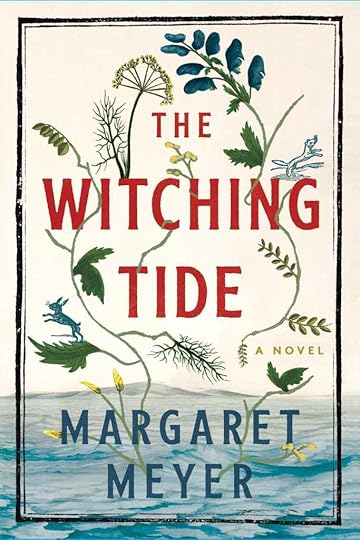Review: The Witching Tide by Margaret Meyer

How many historical novels about women being accused of, and/or actually being witches can I read? Well, the number is infinite, as this subject with forever interest met with its intersection of social history, feminism, gender politics, othering, etc. That said, The Witching Hour by Margaret Meyer has been on my TBR for a while. I really don’t understand the current 3.3 average rating it has on Goodreads, because I quite enjoyed it and found it a very engaging, fast read.
The Witching Tide focuses on middle aged servant and “wise woman” Martha, a mute who lives with an unidentified condition that causes her to cough blood and renders her unable to speak. I presume she had/has consumption and perhaps blew out her vocal cords early in the disease from coughing? It’s hard to know for sure, but the author curiously describes the affliction as a worm living in her throat which makes it all the more unsettling. Martha’s village of Cleftwater is thrown into chaos when the Witchfinder Silas Makepeace comes to town and begins drumming up a frenzy of accusations against various women. I couldn’t help but think of the 1968 Vincent Price film Witchfinder General (based on a book.) The events in The Witching Tide are based on the true witch trials of 1645 (not far from my own family’s origins, in fact.)
Martha’s household is thrown into disarray when her fellow servant Prissy is taken into custody for her alleged hand in the death of a newborn both she and Martha helped birth. In truth, the child was born deformed with a condition that would not have allowed it to live. The mother’s sister, Jennet, is also taken into custody with ties to the child’s death. As these women are taken, Martha feels both helpless and ashamed because by the Witchfinder’s logic, shouldn’t she be next for arrest? What’s more, Martha keeps secret her own mother’s “wise woman” ways and carries with her an inherited wax poppet that may or may not be an actual source of power for Martha. Martha’s master, Kit, soon makes a deal with the Witchfinder and his lead Search Woman to protect Martha in that she too, with her healing skills, becomes a Search Woman. I found this portion of the novel to be the most interesting and engaging. This search function essentially means she inspects the bodies of the accused witches for any marks of the devil and/or extra teats from which their imps suckled. The stretches and reasonings that were made to accuse women will be utterly ludicrous to modern readers, but I am sure the author based these details on true accounts. For example, one woman has a birthmark on her cheek which is taken as a devil’s mark. Another woman has what I assumed to be skin tags beneath her breast which were taken as teats for imps!
Martha walks the line for a time, but she too cannot escape the frenzied accusations. What culminates is a formed sisterhood for survival among the women, as is the case with many of these types of stories as well as in real life with women who are othered and ostracized by society if they have endured SA, for example. Martha’s poppet becomes a character itself as its form and use changes to a channel of power and strength for the women. The group fights for survival amidst the most brutal and sickening means. My only confusion with this novel was how Martha’s fate comes to be, as it is not explained in detail.
Meyer’s writing style may not be everyone’s cup of tea: it is more telling instead of showing, and I do believe this style has a time and place if done right. In my opinion, she pulls it off with thoughtful, meaningful wording and prose that serve the themes of the narrative.



